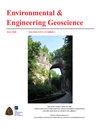Assessment of water quality status in the impact area of the “Piškornica” landfill
IF 0.7
4区 工程技术
Q4 ENGINEERING, ENVIRONMENTAL
引用次数: 0
Abstract
Disposal of household and industrial waste at the Piškornica site began in 1982 on what was then an unmanaged landfill cell, which allowed contamination to pass into underground layers. Landfill rehabilitation was conducted between 2005 and 2013 and conformed to the environmental protection conditions and measures that were prescribed by an EIA procedure, but rehabilitation still has not been fully completed. An environmental permit was issued for rehabilitation of the landfill. The decision and environmental permit prescribed groundwater quality monitoring. Prior to these documents, five piezometers were placed into operation in 1991. The objective of this paper is to determine the potential differences in ground and surface water quality that may have resulted from landfill operations, effectiveness of the rehabilitation efforts, and the potential risk of contamination of the Ivanščak water well. The results of the research were subjected to statistical analyses (e.g., T-test and ANOVA). Based on the regional flow model, a numerical groundwater flow model and contamination transport model were created, which provided scenarios for the potential spread of pollution from the Piškornica landfill while considering different water well operation regimes. It was concluded that a) even though rehabilitation has not been completed, the groundwater quality status improved and b) none of the analysed real flow scenarios generated redirection of streamline patterns towards the Ivanščak water well. Considering future development and likely increase of the Ivanščak well capacity, the expansion of monitoring was proposed for additional measuring locations.“Piškornica”垃圾填埋场影响区域水质状况评价
1982年开始在Piškornica处理家庭和工业废物,当时那里是一个无人管理的垃圾填埋场,导致污染物进入地下。堆填区的修复工程于2005年至2013年进行,符合环评程序规定的环境保护条件和措施,但修复工程仍未完全完成。环保署已发出环境许可证,以修复该堆填区。该决定和环境许可证规定了地下水水质监测。在这些文件之前,1991年有5个压电计投入使用。本文的目的是确定填埋作业可能导致的地表水和地下水质量的潜在差异,修复工作的有效性,以及Ivanščak水井污染的潜在风险。对研究结果进行统计分析(如t检验和方差分析)。在区域流模型的基础上,建立了地下水流数值模型和污染输运模型,在考虑不同水井运行方式的情况下,提供了Piškornica填埋场污染潜在扩散的情景。结果表明:a)尽管修复尚未完成,但地下水水质状况有所改善;b)所分析的实际水流情景均未产生流向Ivanščak井的流线模式重定向。考虑到未来的发展和Ivanščak井产能的可能增加,建议扩大监测范围,增加测量点。
本文章由计算机程序翻译,如有差异,请以英文原文为准。
求助全文
约1分钟内获得全文
求助全文
来源期刊

Environmental & Engineering Geoscience
地学-地球科学综合
CiteScore
2.10
自引率
0.00%
发文量
25
审稿时长
>12 weeks
期刊介绍:
The Environmental & Engineering Geoscience Journal publishes peer-reviewed manuscripts that address issues relating to the interaction of people with hydrologic and geologic systems. Theoretical and applied contributions are appropriate, and the primary criteria for acceptance are scientific and technical merit.
 求助内容:
求助内容: 应助结果提醒方式:
应助结果提醒方式:


